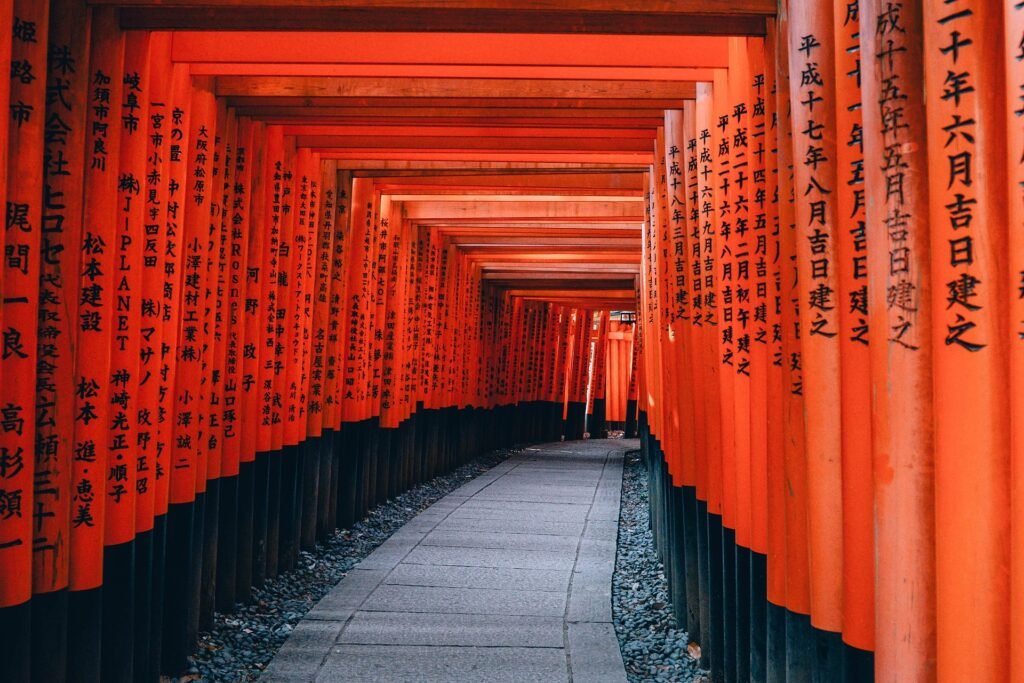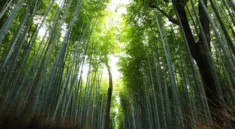
In the ancient city of Kyoto, where traditional culture and timeless beauty meet, lies a sacred path unlike any other in the world: the trail of thousands of vermilion torii gates that wind their way through the forested slopes of Mount Inari. This spiritual pathway leads pilgrims and travelers alike through the enchanting grounds of Fushimi Inari Taisha, one of the most revered Shinto shrines in all of Japan.
More than just a beautiful photo spot, the vibrant gates form an immersive experience—a walk that awakens the senses, connects the spirit with nature, and reveals centuries of Japanese religious tradition. Whether you’re drawn by the striking visual of endless red arches, the sacred atmosphere of the forested mountain, or the deeper meanings embedded in every step, walking through the torii of Fushimi Inari is a once-in-a-lifetime experience that stays with you long after you descend.
The Origins of Fushimi Inari Taisha
Founded in 711 AD, Fushimi Inari Taisha is dedicated to Inari Ōkami, the Shinto deity of rice, prosperity, agriculture, and business. Inari is also associated with foxes (kitsune), who are considered messengers of the god. This connection explains the countless fox statues and offerings of rice scattered throughout the shrine grounds.
Initially built on Inariyama Hill, the shrine was later moved to its current location in southern Kyoto during the Heian period. Over the centuries, it has become not just a religious hub, but a cultural symbol of Kyoto and Japan.
Today, Fushimi Inari is the head shrine of over 30,000 Inari shrines found across Japan, making it a spiritual epicenter and an architectural marvel.
The Torii Gates: Symbolism and Spectacle
What sets Fushimi Inari apart from any other shrine is its Senbon Torii, or “thousands of torii gates,” that form tunnels of brilliant vermilion. These gates line the 4-kilometer trail up Mount Inari, each one donated by individuals, families, or companies in hopes of receiving good fortune and prosperity.
Each torii gate is inscribed with the name of the donor and the date of donation, written in bold black kanji. This practice began in the Edo period and continues to this day, with new gates regularly added to replace aging ones.
The color vermilion (a bright red-orange) is symbolic in Shinto—it represents life force, protection from evil, and purification. As sunlight filters through the gates and dapples the forest floor, the atmosphere becomes nothing short of mystical.
Walking The Sacred Trail: A Journey Through Time and Spirit
The walk through Fushimi Inari is not merely a hike—it is a pilgrimage.
Main Shrine (Honden)
Your journey begins at the base of the shrine, where visitors pass through the Rōmon Gate, donated by Toyotomi Hideyoshi, one of Japan’s most powerful samurai leaders. This grand entrance leads to the Honden, the main hall of worship. Here, worshippers pray for blessings, health, success, and safe journeys.
Senbon Torii (Thousand Gate Path)
Just behind the main hall begins the famous tunnel of torii gates. This path forks early into two parallel trails—both lined with gates—before rejoining further up the mountain. The density of gates here is astonishing; it’s where the famous images and photos are taken.
As you walk, the crowd begins to thin, the sounds of Kyoto fade away, and the surroundings become increasingly serene. The higher you climb, the more meditative the journey becomes.
Yotsutsuji Intersection
About halfway up the mountain (roughly 30–40 minutes into the walk), you’ll reach the Yotsutsuji viewpoint, where the torii give way to a panoramic vista of Kyoto city below. Many visitors choose to stop here, as it marks a transition from the densely packed gates to a more natural and spiritual forest path.
Mountain Summit
Continuing the climb, the path winds through quiet woods, miniature shrines, stone fox statues, and offering sites. Reaching the summit of Mount Inari (233 meters high) is not about conquering a peak, but fulfilling a pilgrimage. The air is cool, and the silence is profound. It’s here that you feel deeply connected with the spiritual energy of Inari and the long history of devotion that has marked this mountain for over a thousand years.
Fox Spirits and Offerings: The Mysticism of Kitsune
Throughout the shrine, you’ll encounter numerous fox statues wearing red bibs. In Japanese folklore, foxes are considered messengers of Inari and are believed to possess magical powers, including shape-shifting and warding off evil spirits.
These statues often hold symbolic objects in their mouths: a key (to the rice granary), a scroll (wisdom), or a jewel (spiritual energy). Offerings of rice, sake, and coins are left at their feet by worshippers seeking blessings.
This reverence for kitsune adds a layer of mysticism to the already spiritual journey, especially as the trail winds through shaded forests and quiet groves, evoking a sense of ancient wonder.
Fushimi Inari in Different Seasons and Times of Day
One of the most magical things about Fushimi Inari is how it transforms with the seasons:
- Spring: The cherry blossoms bloom around the shrine grounds, creating a soft pink contrast to the red gates.
- Summer: The dense forest provides a cool respite from the city heat, and festivals add vibrant life to the sacred paths.
- Autumn: Fiery red and gold leaves mirror the torii, creating an explosion of color.
- Winter: A light dusting of snow gives the shrine a serene, almost ethereal quality.
Visiting at dawn or dusk enhances the experience further. Early mornings offer solitude and the sounds of nature, while twilight bathes the torii in a warm glow, and lanterns begin to flicker on along the trail.
Cultural and Cinematic Legacy
Fushimi Inari has captured the imagination of not only pilgrims but also writers, artists, and filmmakers. One of the most famous appearances was in the movie Memoirs of a Geisha, where the young protagonist runs through the torii in a scene that has become iconic.
The shrine is also featured in anime, manga, literature, and travel journals, adding to its mythic status. It represents not only spiritual devotion but also the beauty of Japanese aesthetics, where nature, architecture, and meaning blend seamlessly.
Practical Tips for Visiting
To make the most of your spiritual walk through Fushimi Inari, keep these tips in mind:
- Admission: The shrine is open 24 hours a day, and entry is free.
- Best Time to Visit: Early morning (before 9 AM) or late afternoon (after 5 PM) to avoid crowds and enjoy peace.
- Footwear: Wear comfortable walking shoes, especially if you plan to reach the summit. The path is steep and can be slippery in rain.
- Duration: The full round-trip hike to the summit takes about 2 to 3 hours, depending on pace and stops.
- Etiquette: Be respectful—this is an active religious site. Avoid shouting, littering, or standing in the middle of paths for too long.
- Shopping & Food: The road leading up to the shrine is lined with street vendors selling traditional snacks like inari sushi, yakitori, and matcha sweets.
More Than Just A Shrine: A Spiritual Pilgrimage
In a country where modern technology and ancient tradition coexist, Fushimi Inari Taisha offers something rare: an authentic, unfiltered glimpse into the spiritual soul of Japan. Every gate, every stone step, and every forest breeze whispers stories of devotion, prosperity, and divine presence.
Whether you come seeking blessings, beauty, or inner peace, your walk through the vermilion gates becomes a personal journey—as much inward as upward. And when you descend, you’ll carry with you more than photos or souvenirs; you’ll bring back a feeling of quiet clarity and reverence that only such a sacred space can inspire.




